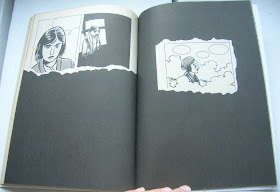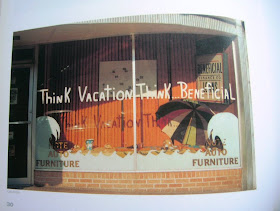 I read this book for my high school AP English class. We also read Beloved by Toni Morrison, and afterwards the teacher asked us to write a paper on which one we liked better and why. Which seems a little odd. But the point is that I was only one of two people in the class who preferred The Sound and the Fury, which I find kind of interesting.It's a notoriously difficult book, but I remember that once I started reading a particular section and really got into the rhythm and feel of a character's thought processes, however confused and tortured they might be, I could actually kind of follow it. (I'm sure I missed some details here and there.) I'd never read anything like it, that was for sure.
I read this book for my high school AP English class. We also read Beloved by Toni Morrison, and afterwards the teacher asked us to write a paper on which one we liked better and why. Which seems a little odd. But the point is that I was only one of two people in the class who preferred The Sound and the Fury, which I find kind of interesting.It's a notoriously difficult book, but I remember that once I started reading a particular section and really got into the rhythm and feel of a character's thought processes, however confused and tortured they might be, I could actually kind of follow it. (I'm sure I missed some details here and there.) I'd never read anything like it, that was for sure.
I started to re-read it about five years ago but never finished for some reason. I should try it again.
 This oral history of the small, short-lived, yet influential No Wave scene includes contributions from the likes of Lydia Lunch, James Chance, Arto Lindsay, Glenn Branca, Diego Cortez, and so on, with longer written sections by Byron Coley, and many black and white photographs and fliers throughout the pages.The late 70s/early 80s was a time in New York history that will never come back, a virtual madhouse where you could live cheaply and do what you wanted. In Luc Sante's essay "My Lost City" (which I am forever quoting), he writes of a feeling of nature taking back the city, of feral dogs and vacant streets, how "in the 1970s New York City was not a part of the United States at all. It was an offshore interzone with no shopping malls, few major chains, very few born-again Christians who had not been sent there on a mission, no golf courses, no subdivisions." This is the landscape that the no wave scene was born into, and it's one that I am forever pining for, wishing that I could have lived through, despite knowing in the back of my mind that it must not have been as romantic as it sounds on paper.In the book's Foreword, Lydia Lunch writes, "The anti-everything of No Wave was a collective caterwaul that defied categorization, defiled the audience, despised convention, shit in the face of history, and then split..No Wave was the waste product of Taxi Driver, Times Square, the Son of Sam, the blackout of '77...and the desperate need to violently rebel against the complacency of a zombie nation dumbed down by sitcoms and disco." (There's a longer list in between ellipsis but you get the point.)
This oral history of the small, short-lived, yet influential No Wave scene includes contributions from the likes of Lydia Lunch, James Chance, Arto Lindsay, Glenn Branca, Diego Cortez, and so on, with longer written sections by Byron Coley, and many black and white photographs and fliers throughout the pages.The late 70s/early 80s was a time in New York history that will never come back, a virtual madhouse where you could live cheaply and do what you wanted. In Luc Sante's essay "My Lost City" (which I am forever quoting), he writes of a feeling of nature taking back the city, of feral dogs and vacant streets, how "in the 1970s New York City was not a part of the United States at all. It was an offshore interzone with no shopping malls, few major chains, very few born-again Christians who had not been sent there on a mission, no golf courses, no subdivisions." This is the landscape that the no wave scene was born into, and it's one that I am forever pining for, wishing that I could have lived through, despite knowing in the back of my mind that it must not have been as romantic as it sounds on paper.In the book's Foreword, Lydia Lunch writes, "The anti-everything of No Wave was a collective caterwaul that defied categorization, defiled the audience, despised convention, shit in the face of history, and then split..No Wave was the waste product of Taxi Driver, Times Square, the Son of Sam, the blackout of '77...and the desperate need to violently rebel against the complacency of a zombie nation dumbed down by sitcoms and disco." (There's a longer list in between ellipsis but you get the point.)
 A family tree of bands at the beginning of the book. It may look like a lot but a lot of the same people were in the various groups.
A family tree of bands at the beginning of the book. It may look like a lot but a lot of the same people were in the various groups. Here's Brian Eno, who was more of an early adopter of No Wave than a pioneer. But he's still a pretty cool guy.
Here's Brian Eno, who was more of an early adopter of No Wave than a pioneer. But he's still a pretty cool guy. I really like the simple typographic flier.
I really like the simple typographic flier. Lydia Lunch: the baby-faced killer.
Lydia Lunch: the baby-faced killer. James Chance attacking Village Voice writer Robert Christgau, who apparently was unfazed and continued to praise the Contortions.
James Chance attacking Village Voice writer Robert Christgau, who apparently was unfazed and continued to praise the Contortions. On the left, the Contortions playing on a roof somewhere; on the right, Mirielle Cervenka (older sister of Exene and one-time member of DNA) on the subway. (You may recall the scene in The Decline of Western Civilization when Exene learns the news of her sister's death.)
On the left, the Contortions playing on a roof somewhere; on the right, Mirielle Cervenka (older sister of Exene and one-time member of DNA) on the subway. (You may recall the scene in The Decline of Western Civilization when Exene learns the news of her sister's death.)
 One of Simenon's romans durs (the current NYRB edition has been retitled to Three Bedrooms in Manhattan for some reason), in which two lonely and desperate people meet late one night at an all-hours diner in New York. Together they move from one bar to another, and then from bedroom to bedroom around the city (a hotel, hers, and then his). You can almost visualize the thick haze of smoke, whiskey, and desperation present throughout the book. The writing is hard, unsentimental, and spare--romantic and yet not. The noirish elements might almost be a bit much--it definitely doesn't live up to The Widow, which is still my favorite.
One of Simenon's romans durs (the current NYRB edition has been retitled to Three Bedrooms in Manhattan for some reason), in which two lonely and desperate people meet late one night at an all-hours diner in New York. Together they move from one bar to another, and then from bedroom to bedroom around the city (a hotel, hers, and then his). You can almost visualize the thick haze of smoke, whiskey, and desperation present throughout the book. The writing is hard, unsentimental, and spare--romantic and yet not. The noirish elements might almost be a bit much--it definitely doesn't live up to The Widow, which is still my favorite.  Simenon's many praises.
Simenon's many praises.
 Not too long ago I read Rick Moody's latest novel, The Four Fingers of Death, and I wasn't all that crazy about it. It's ambitious, for sure--three novels in one, using satire and humor to explore themes of ennui and interpersonal relationships (in this case, on the planet Mars), but it just didn't do anything for me. I can't really say why. Helpful, I know. But I loved his earlier work when I first read it--for instance, this collection of short stories, Demonology, which I remember first reading and wanting to do that. One of my favorites in this volume is "Wilkie Fahnstock: The Boxed Set," in which the story of a man's life is told as a series of music tracks and accompanying liner notes. ("Tragedy struck in 1970, when Elise Fahnstock's marriage to Stannard Buchanan Fahnstock ended in acrimonious divorce--to the sounds of Simon and Garfunkel's Bridge Over Troubled Water.") It's a pretty good mix.
Not too long ago I read Rick Moody's latest novel, The Four Fingers of Death, and I wasn't all that crazy about it. It's ambitious, for sure--three novels in one, using satire and humor to explore themes of ennui and interpersonal relationships (in this case, on the planet Mars), but it just didn't do anything for me. I can't really say why. Helpful, I know. But I loved his earlier work when I first read it--for instance, this collection of short stories, Demonology, which I remember first reading and wanting to do that. One of my favorites in this volume is "Wilkie Fahnstock: The Boxed Set," in which the story of a man's life is told as a series of music tracks and accompanying liner notes. ("Tragedy struck in 1970, when Elise Fahnstock's marriage to Stannard Buchanan Fahnstock ended in acrimonious divorce--to the sounds of Simon and Garfunkel's Bridge Over Troubled Water.") It's a pretty good mix.
 In the early 70s, photographer Stephen Shore embarked on a series of cross-country road trips, documenting what he found along the way. These photographs, which are comprised mostly of images of meals, hotel rooms, and people he encountered, as well as decrepit-looking storefronts, are collected chronologically in American Surfaces.
In the early 70s, photographer Stephen Shore embarked on a series of cross-country road trips, documenting what he found along the way. These photographs, which are comprised mostly of images of meals, hotel rooms, and people he encountered, as well as decrepit-looking storefronts, are collected chronologically in American Surfaces.
Despite the banality of the subjects, the striking colors and composition transcend them beyond the typical vacation snapshot. The extremely saturated colors, coupled with the subjects themselves, remind me a lot of William Eggleston's work.
 I read this book for my high school AP English class. We also read Beloved by Toni Morrison, and afterwards the teacher asked us to write a paper on which one we liked better and why. Which seems a little odd. But the point is that I was only one of two people in the class who preferred The Sound and the Fury, which I find kind of interesting.
I read this book for my high school AP English class. We also read Beloved by Toni Morrison, and afterwards the teacher asked us to write a paper on which one we liked better and why. Which seems a little odd. But the point is that I was only one of two people in the class who preferred The Sound and the Fury, which I find kind of interesting.






















